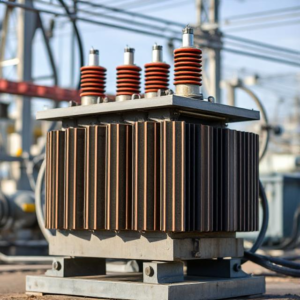What is a Transformer? A Simple and Detailed Explanation
A transformer is an electrical device that changes the voltage of an alternating current (AC) in a circuit. It is one of the most important devices used in electrical power distribution and transmission.
Let’s break it down step by step in a simple and easy-to-understand way.

How Does a Transformer Work?
At its core, a transformer works based on the principle of electromagnetic induction. It transfers electrical energy between two circuits by using a magnetic field to induce a voltage.
Here’s the process:
- AC Power Input: A transformer is connected to an alternating current (AC) power supply. The AC power is passed through a coil of wire called the primary coil.
- Magnetic Field Creation: When the AC current flows through the primary coil, it creates a magnetic field around the coil. Since AC is constantly changing direction, the magnetic field also changes continuously.
- Magnetic Induction: This changing magnetic field passes through a core (often made of iron) and reaches the secondary coil, which is placed near the primary coil. The changing magnetic field induces an electric current in the secondary coil through electromagnetic induction.
- AC Power Output: The induced current in the secondary coil produces a voltage (AC) in the secondary circuit. Depending on the number of turns (loops) of wire in the secondary coil, the voltage can either be increased or decreased compared to the primary coil.
Key Parts of a Transformer
- Primary Coil (Winding):
- The primary coil is the input coil where the alternating current (AC) enters the transformer.
- It is connected to the power source.
- Secondary Coil (Winding):
- The secondary coil is the output coil that delivers the transformed voltage to the load.
- It is connected to the device or system that will use the power.
- Core:
- The core is usually made of a soft magnetic material (like iron or steel) and serves as a path for the magnetic field.
- The core helps to direct the magnetic field from the primary coil to the secondary coil efficiently.
Types of Transformers
Transformers can be classified based on their function and the number of coils:
- Step-Up Transformer:
- A step-up transformer increases the voltage from the primary coil to the secondary coil.
- This means the secondary coil has more turns of wire than the primary coil.
- Example: A step-up transformer might be used to raise the voltage for transmission over long distances in power lines.
- Step-Down Transformer:
- A step-down transformer decreases the voltage from the primary coil to the secondary coil.
- This means the secondary coil has fewer turns of wire than the primary coil.
- Example: A step-down transformer is used to lower the voltage from the high-voltage transmission lines to the standard voltage used in homes (like 110V or 220V).
Voltage and Turns Ratio (The Formula)
The relationship between the number of turns in the primary coil and the secondary coil determines whether the transformer is a step-up or step-down transformer and how much the voltage changes. This relationship is given by the turns ratio formula:
Where:
= voltage in the secondary coil
= voltage in the primary coil
= number of turns in the secondary coil
= number of turns in the primary coil
Example:
- If the primary coil has 100 turns and the secondary coil has 200 turns, the voltage in the secondary coil will be twice that in the primary coil (a step-up transformer).
- If the primary coil has 200 turns and the secondary coil has 100 turns, the voltage in the secondary coil will be half that in the primary coil (a step-down transformer).
What is the Purpose of a Transformer?
Transformers are used for several important reasons in electrical systems:
- Voltage Conversion:
- Transformers allow us to easily increase or decrease voltage to suit different needs. For example, electrical power is transmitted over long distances at high voltage (to reduce energy loss), and then the voltage is stepped down to a safe level for use in homes and businesses.
- Efficient Power Transmission:
- High voltage is used for transmitting power over long distances because it reduces the energy lost as heat in the wires. Using transformers, we can step up the voltage at the power station and step it down at the destination, making the entire process more efficient.
- Safety:
- Transformers allow us to use safe and usable voltages for household appliances, electric devices, and equipment.
Advantages of Transformers
- Energy Efficiency:
- Transformers are very efficient in transferring energy from one circuit to another. Most modern transformers can achieve efficiency levels over 95%.
- Voltage Regulation:
- Transformers help regulate the voltage in a system, ensuring that the voltage is at the correct level for the specific application.
- No Moving Parts:
- Transformers don’t have moving parts (except in certain types), making them highly reliable and low-maintenance.
Limitations of Transformers
- AC Only:
- Transformers only work with alternating current (AC) because they rely on a changing magnetic field to induce voltage. They cannot be used with direct current (DC).
- Size and Cost:
- Large transformers (like those used for power distribution) can be expensive and take up a lot of space.
Example of How Transformers Are Used
- Power Transmission:
- Electricity is generated at a power plant at a relatively low voltage, then sent through step-up transformers to increase the voltage for long-distance transmission. When it reaches homes, step-down transformers reduce the voltage to a safe level (like 110V or 220V) that can be used in devices like refrigerators, lights, and computers.
- Electronics:
- Transformers are also used in electronic devices like chargers and adapters to adjust the voltage from the outlet to the level needed for the device (for example, from 120V AC to 9V DC for a phone charger).
Summary
- A transformer is a device that changes the voltage of alternating current (AC) using electromagnetic induction.
- It consists of two coils (primary and secondary) wrapped around a magnetic core.
- Step-up transformers increase voltage, and step-down transformers decrease voltage.
- They are used for efficient power transmission, voltage regulation, and ensuring electrical safety.
- Transformers are found in power distribution systems, electronics, and many other applications.
Transformers play a critical role in modern electrical systems, enabling the efficient transmission and safe use of electrical energy.
Balanced and Unbalanced 3-Phase Loads
AC Circuits and Power Systems : Explain


